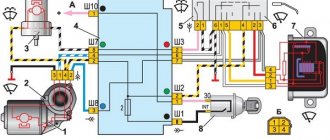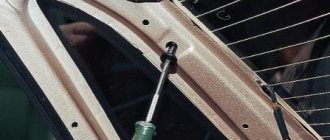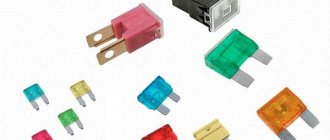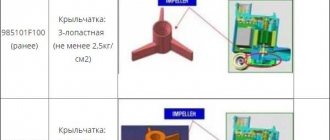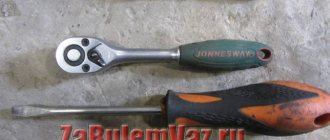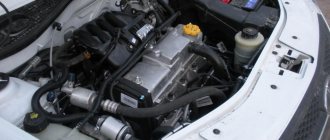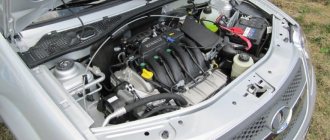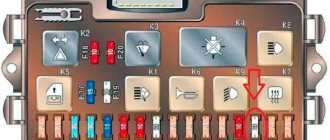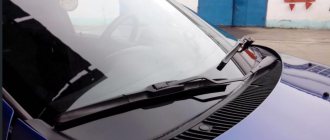Lada Largus windshield washer does not work
Owners of Lada Largus often face the problem of a non-working window washer. Although the system is quite simple, breakdowns in it are no exception. Let's look at all the possible reasons that affect the performance of the Lada Largus washer.
The first and most common reason is the lack of fluid in the washer reservoir. Yes, you can’t call it a breakdown, but before you disassemble the car and buy new parts, you need to make sure that there is liquid in the washer system - water or anti-freeze. After all, there are often cases when a person contacts the service because the washer is not working, and they tell him that he just needs to add water to the tank.
The second reason is that the supply hoses are pinched, broken, or torn. This is a very common breakdown in Largus, especially when it comes to the back door. There the corrugation often breaks and the washer fluid leaks out under the rear bumper. Diagnostics is simple - turn on the washer and listen to whether the motor is working. It is better to do this with the engine off and the ignition on. If the motor hums, and you will definitely hear it, and water does not flow from the nozzles, then look where it will flow. If the tube is broken, you will definitely see streaks of windshield washer fluid under the car.
The third reason is clogged injectors. This very often happens if you use water with mechanical impurities or low-quality washer fluid. Or, simply put, the nozzle could get stuck in the cold if the system had previously been filled with plain tap water. It's very easy to check - remove the supply tube from the nozzle, turn on the washer and if water starts flowing, the problem is in the nozzle. You can try to clean/warm the injector. If it doesn’t help, we buy a new one and install it in place of the broken one. The problem is cheap and the work is simple.
The fourth reason may lie in the electrical part. For example, the washer motor broke down. If you are not sure of the performance of the motor, then do not rush to immediately buy a new one. We must finally make sure that this is the case. The simplest way is to apply voltage to the motor and see if it hums. Polarity doesn't matter.
But even here, not everything is so simple. The motor itself may be humming, but the pump may not be working. To do this, we apply voltage to the motor (polarity is important here) and place its intake in the water. If water comes out of the outlet, it means the motor is working. Otherwise, the motor should be replaced with a new one.
The fifth reason is the fuse. Yes, the fuse shouldn’t just burn out, but you still need to start checking the fuse almost immediately after a breakdown. The Lada Largus washer fuse is located in the dashboard mounting block. Fuse numbers in the diagram are F01 (20A) and F27 (20A). They need to be dismantled and ringed. If the fuse is blown, then we replace them with new ones of the appropriate rating.
And the sixth reason is a non-working switch in the car. Yes, this part rarely fails, but nevertheless, if other checks have not yielded results, then it should be checked too.
You can try to fix a faulty switch by disassembling its housing and checking its condition. If the problem is oxides or weak contacts, then you can try to clean and repair everything. In other cases, it is easier to buy a new switch.
Lada Largus washer reservoir where is it located
Cars admin26.02.2020
Note: Part numbers for the front washer can be found here and the rear washer can be found here Please note that the windshield washer pump (motor) differs depending on whether the rear washer is installed, i.e. may have one or two fittings.
Washer pump with two fittings: 1 – fitting for supplying liquid to the glass of the tailgate; 2 – electric motor; 3 – electrical connector; 4 – fluid supply fitting to the windshield
We carry out work when the pump fails and the washer reservoir is damaged (leaky). Disconnect the wire terminal from the negative terminal of the battery.
Remove the seal from the bulkhead of the front panel.
Using a screwdriver, pry off the piston pin and remove the piston fastening the right windshield trim
Remove the hose from the holder on the windshield trim.
Remove the right windshield trim.
Having released the clamp of the wire block, disconnect the block from the washer pump.
Using a 10mm socket, unscrew the bolt securing the washer fluid reservoir.
We remove the hose seal from the recess in the bulkhead of the bulkhead.
By turning the tank, we remove the hose from the recess of the bulkhead of the bulkhead (the arrow indicates the recess).
We remove the tank from the drainage box.
. and, prying the pump with a screwdriver, remove it from the tank.
Remove the washer reservoir.
Remove the pump seal from the reservoir.
There is a strainer at the bottom of the sealing sleeve. If the bushing is torn, cracked or has lost elasticity, replace it with a new one.
Remove the fluid supply hoses to the washer nozzles from the pump fittings and remove the pump.
Install the washer pump and reservoir in reverse order. We connect the hoses to the pump fittings: to the white fitting - the fluid supply hose to the nozzle on the tailgate door (with an L-shaped fitting, see position A in the previous photo); to the black fitting - a hose for supplying fluid to the injectors on the hood.
Video
Lada Largus - where is the washer reservoir?
The Lada Largus washer reservoir is located under the hood of the car on the passenger side on a plastic frill. The photo shows where the washer reservoir is located:
There is one reservoir for the front and rear washers.
The article number of the Lada Largus washer reservoir is 289106288R.
Washer nozzle Lada Largus
To replace and search, use article number 77 00 846 456. This part looks like this:
How to remove the washer reservoir on a Largus
Lada Largus, like any other car, has certain disadvantages. Some shortcomings can be ignored, while others are best eliminated as quickly as possible. An example of such a case could be the washer reservoir; its fastening and shape are not entirely successful, which allows it to peel off the paint of the engine shield.
To check the condition of the paintwork, we remove the Largus washer reservoir. To do this, snap off the clip, remove part of the wind lining (frill), disconnect the hoses and unscrew one screw securing the tank (Torx T30 wrench). This process is also shown in the video:
Under the washer reservoir you can see a damaged area where the paint is no longer there. To prevent this you can do different things:
- perform sound insulation of the engine shield;
- cover the washer reservoir with splen, vibroplast or other material that does not absorb moisture;
- Place rubber seals under the tank.
Also check the condition of the drainage hole and clean it if necessary.
Let us remind you that another drawback of the Lada Largus model is the short fifth gear. But the design of the transmission allows you to change the 5th gear gears without disassembling the entire gearbox or even removing it from the car. Have you experienced paintwork damage due to the washer fluid reservoir? How did you solve the problem?
Note: Part numbers for the front washer can be found here and the rear washer can be found here Please note that the windshield washer pump (motor) differs depending on whether the rear washer is installed, i.e. may have one or two fittings.
Washer pump with two fittings: 1 – fitting for supplying liquid to the glass of the tailgate; 2 – electric motor; 3 – electrical connector; 4 – fluid supply fitting to the windshield
We carry out work when the pump fails and the washer reservoir is damaged (leaky). Disconnect the wire terminal from the negative terminal of the battery.
Article number of the Lada Largus rear door washer tube
As I said above, the most common failure of the rear door washer is the breaking of the tube running between the body and the door. This is a completely natural failure associated with the design of the tube itself, which I would hardly dare to call successful.
You can order the handset using the following article number: 8200766091 It looks like this:
Window washer pump Lada Largus
Pump part number: 6001549443 It looks like this:
Location of the tank under the hood of Renault Logan
On different versions of Renault Logan, the tank is located in different places.
Renault Logan 1st generation
It is located in the engine compartment on the passenger side. Between the hood compartment and the windshield, under a protective decorative plug.
Renault Logan 2nd generation
The washer reservoir on the second generation Renault Logan is located on the left, closer to the edge of the engine compartment (where the passenger is). In the same place as the first generation, but a little to the left.
Lada Largus washer reservoir rubs the body
Please note that the washer reservoir may rub the body at the point of contact. The car's paintwork is wiped, and rust forms on the exposed metal.
Therefore, it is recommended to dismantle the washer reservoir, treat the exposed metal and cover the contact points with sound-insulating material.
In order not to encounter breakdowns of the Lada Largus glass washer in the future, it is recommended to control the washer level in the tank, preventing it from being completely used up, pouring only clean liquid into the system, and also not using plain water in the cold season. Treat your car with care and it will reciprocate.
Where is the washer reservoir in Largus
It is necessary to periodically check the fluid level in the windshield washer reservoir and the tailgate glass and, if necessary, add fluid. At an ambient temperature of +2 °C and below, only special windshield washer fluid or concentrate diluted with water in the required proportions should be poured into the tank. Water or highly diluted windshield washer fluid may freeze in the reservoir, pipes or washer nozzles. Pure water is permissible for use only in the warm season. The windshield washer reservoir is located in the engine compartment on the right side, under the windshield trim.
Open the filler cap of the tank. Visually check the fluid level through the neck. If it is needed…
...add fluid to the reservoir. Close the lid of the glass washer reservoir.
Note: Part numbers for the front washer can be found here and the rear washer can be found here Please note that the windshield washer pump (motor) differs depending on whether the rear washer is installed, i.e. may have one or two fittings.
Washer pump with two fittings: 1 – fitting for supplying liquid to the glass of the tailgate; 2 – electric motor; 3 – electrical connector; 4 – fluid supply fitting to the windshield
We carry out work when the pump fails and the washer reservoir is damaged (leaky). Disconnect the wire terminal from the negative terminal of the battery.
Remove the seal from the bulkhead of the front panel.
Using a screwdriver, pry off the piston pin and remove the piston fastening the right windshield trim
Remove the hose from the holder on the windshield trim.
Remove the right windshield trim.
Having released the clamp of the wire block, disconnect the block from the washer pump.
Using a 10mm socket, unscrew the bolt securing the washer fluid reservoir.
We remove the hose seal from the recess in the bulkhead of the bulkhead.
By turning the tank, we remove the hose from the recess of the bulkhead of the bulkhead (the arrow indicates the recess).
Largus rear window washer reservoir
I remembered my former love (VAZ 2112). There were two tanks, both in the engine compartment. I decided to do something similar here too. You can, of course, put another tank in the engine compartment, on the right in the direction of travel, there is a little space there. A washer reservoir from a VAZ 2104 is suitable for this. But on many cars with a rear windshield wiper, the reservoir is placed at the back, for example a VAZ 2104, or even in the door (Chevrolet Niva). After much thought and fitting in the car shop window, I decided to buy a reservoir from Shniva, it is flatter, and install an additional reservoir for the rear window washer.
Rear window washer reservoir, fan nozzles and valves
Well, I also bought a pump motor, terminals with chips and wires. There were three installation options. The first and main thing, it seemed, was the door. But after removing the door trim, I realized that this was a bad idea. Firstly, there is not enough space in the door, and to accommodate the tank (which also has large walls that are not parallel), you will have to cut out a decent piece of the casing in the area of the recess. However, there was no desire to shred and disfigure the casing. And I have an electric pump lying very conveniently in my niche.
There were two options left, in the right or left trunk pockets. Where the nets are. In the right pocket, the tank sits a little lower due to the slanted bottom and is not so noticeable. But then there is no room for standard tools and the hose needs to be dragged far. Therefore, we put the tank in the left pocket. Moreover, both the hose and the ground connection point are conveniently and close located there. At the same time, I cut off the mounting brackets; they do not extend along the length. All that remains is to stretch the power wire (mine is green, like the one for the front washer). We run the wire parallel to the standard harness; I already have the power wire to the cigarette lighter socket in the trunk and the cable from the rear view camera laid there, so my hand is already full. I connected the hose with one side to the pump, the other to the green adapter, you can install a check valve in the gap.

